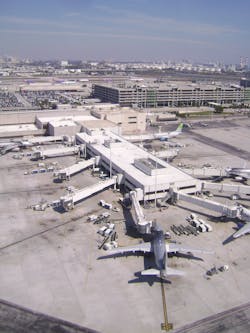In the midst of a runway expansion expected to be completed in September of 2014, Fort Lauderdale-Hollywood International Airport (FLL) has embarked on an initiative to increase the capacity of its airfield.
Dan Bartholomew, manager of airport planning at FLL, says that due to the new 8,000-foot runway, and a plethora of associated geometry that goes along with it, now was the 'perfect scenario' for implementing an airport information management system and electronic airport layout plan (eALP).
A former corporate pilot and aviation consultant, Bartholomew has been with FLL for four years. He relates that the airport's biggest concern with regard to the airfield operations area (AOA) is probably universal:
- Situational awareness on the airfield.
- Incursion management.
"The other concern is since the geometry of the airfield over the next two years is going to be changing in significant ways,” Bartholomew adds, “we need the ability to have continuously updated airfield geometry maps so that individuals riding around on the airfield know where they are at any time."
In addition, the information management system and eALP should prove to be a big benefit helping ramp agents keep up the increased capacity of the workload.
"We are implementing something right now that is equivalent to a virtual ramp control that will be able to track what flights are inbound, what gates they are going to and when there’s an existing aircraft at the gate currently," Bartholomew explains. "That also allows us to do last minute changes … for example, we get a lot of diversions due to thunderstorms; this technology allows us to instantly determine what aircraft can fit in what gates.
"We don’t typically get aircraft types such as the 747 here; we can accommodate them, however our gates are designed for smaller aircraft such as a 737 or 757. If a 747 comes in, we need to know which gates can accommodate that aircraft, and usually we won’t know that until it’s on final approach.
"So the airport information management system will allow us to make better informed decisions in real-time."
FIRST STEPS
When embarking on an eALP initiative, first and foremost, it’s good to have a plan in place, and to know what data to collect and how to collect it.
"For us, the plan has been imperative … it has helped us focus on how we are going to proceed in a very methodical fashion," Bartholomew explains. "It’s important to be aware of all of the types of systems and technology assets are available. We don’t want to collect data in a format that isn’t usable in the various systems we already have in place.
"It is a large endeavor; it requires hiring an aerial photography firm, surveyors, putting the data in a format that meets the FAA advisory circulars, performing all of the quality control checks, and then pushing that data to FAA to get an approved eALP.
For help, Bartholomew called in Woolpert, a design, geospatial and infrastructure management firm based in Dayton, OH.
Mark Ricketson, enterprise information management (EIM) project director for Woolpert, has been an aviation consultant for more than 15 years helping airports with technology business processes and implementation plans.
Lately, Ricketson has been working with what FAA has been asking airports to comply with: new geographic information system (GIS) standards. Ricketson spent a year as acting GIS manager for the Hartsfield-Jackson Atlanta International Airport, and has been with Woolpert for "I think eventually every airport will have an eALP; that is certainly the FAA’s goal,” Ricketson adds. “The FAA intends to have Part 139 airports completed in say the next five to 10 years. In the long run, the FAA’s plan is to focus on the large hub airports, then medium, then small, and on down the line.”
PREVENTING INCURSIONS
"Right now we are looking at ways to connect some locators on our operations maintenance vehicles and grabbing feed from the ASDE-X feed [ground-based situational awareness radar]," Bartholomew says.
ASDE-X is a runway-safety tool that enables air traffic controllers to detect potential runway conflicts by providing coverage of movement on runways and taxiways. By collecting data from a variety of sources, ASDE-X is able to track vehicles and aircraft on airport surfaces and obtain identification information from aircraft transponders.
"So basically having a transponder in each vehicle that connects to the ASDE-X feed for the tower so it knows where everyone is at on the airfield at any particular time," Bartholomew explains. "Also, individual ops people will know where other ops people are at any given time."
Comments Ricketson: "There have been some cases where we have almost had some accidents because we lack situational awareness, and the FAA is testing some technologies utilizing the ASDE-X feed so that all vehicles on the airfield have the ability to understand where they are in relation to other vehicles and people moving on the airfield.”
The weaknesses can be seen around the gates, according to Ricketson. “Because the airplanes aren’t necessarily transponding in and around the gates you know something is there, you just don’t know the type of aircraft it is.
"As far as the data goes, as the eALP data comes more prevalent across the airport industry, it will be used for many things that airports have not even thought of yet.
"The data is very accurate; it’s survey-grade data — it is certainly going to be useful for any of the NextGen GPS navigation-based technologies."
The asset management, maintenance management, and work order management lifecycle of being able to do inspections in the field and conduct real-time communication of where there may be a maintenance or safety issue, and being able to feed that information to somebody who can take care of the issue is a huge need for airports, he relates.
There are many airports that do not have a wireless network on the airfield and are relying on radio and cellular communication that isn’t able to feed a large bandwidth of information, Ricketson says.
"As airports like Atlanta and others start to install wireless on the airfield,” he adds, “you can start to utilize the network and perform real-time mapping with mobile devices.”
TIME AND COST
For airports with limited resources, mobile technology can help, says Ricketson. "There are already folks who have eyes on a lot of these assets, whether it’s airfield lighting or pavement, if you can enable those folks with a mobile device, they can not only use it to help them find the light that went out last night, but also to help keep data maintained and fresh."
From start to finish, the FLL eALP took a little more than a year and a half to complete.
The cost has been negligible, according to Bartholomew.
"The FAA has provided essentially a roadmap on how to collect GIS data … we decided to write that into our specifications for our new airfield, and we also added in our existing airfield to that," he adds. "All the data that is being required for the eALP is also required for the runway template action plan process that we have for the new runway. That includes airfield geometry and location of buildings as well as any airspace obstructions. Because we had to collect it anyway, we decided to collect it so that it meets the advisory circulars’ standards. So we built an eALP out of information that we had to gather anyway."
Woolpert is currently finishing up eALP projects in Denver and Tulsa, are two-thirds the way through San Francisco, and is a sub-consultant on the project in Orlando. "We have doing this at probably well over 25 airports right now," says Ricketson.
"We also do a lot of work for the WAAS (Wide Area Augmentation System) program for the FAA … if you are looking for that kind of procedure at the airport, you have to have an aeronautical survey done. We’ve done at least a couple hundred WAAS airports around the country over that past five or six years. Those are less than the eALP, but they must comply with at least some of the standards that are part of FAA’s advisory circulars, and could be considered a component of an eALP."
About the author: Brad McAllister was the editor of Airport Business and served on the staff for four years. He is currently the director of marketing for Air T.


